Multi-Objective Sizing Optimization of Hybrid Renewable Energy Microgrid in a Stand-Alone Marine Context
Abstract
1. Introduction
2. Selection and Modeling of System Components
2.1. Resources Characterization and Components Selection
2.2. Wind Turbine Model
2.3. Tidal Current Turbine Model
2.4. Battery Storage System Model
3. Objective Functions and Constrains
3.1. Optimization Objectives
3.1.1. Loss of Power Supply Probability
3.1.2. Cost of Energy
3.1.3. Dump Energy Probability
3.2. Objective Function and Constraints
3.2.1. Variable Constraints
3.2.2. Generation Unit Boundaries
3.2.3. Supply-Demand Balance
3.2.4. BSS Constraints
3.3. Energy Management Strategy
- Renewable energy power generation is enough to match the load demand.
- If the BSS is not fully charged at this time, the excess power generation will charge the BSS.
- If the BSS is fully charged at this time, the renewable energy output will be reduced to match the load. Record the dump energy.
- 2.
- Renewable energy power generation is not enough to match the load demand.
- If the BSS is available at this time, the BSS will discharge to match the load demand.
- If the BSS is not available at this time, the unsatisfiable load will be cut off. Record the failure time of power supply.
4. Improved Multi-Objective Grey Wolf Optimizer
4.1. Multi-Objective Grey Wolf Optimizer
4.2. Improvement of MOGWO
4.2.1. Halton Sequence Initialization
4.2.2. Social Motivation Strategy
4.3. Verification of HSMGWO
4.4. Flowchart of Optimization
- Input the load, wind speed, tidal current speed and other data of the studied island. Input the economic and technical parameters of the system components.
- Determine the system optimization objectives and constraints. Determine the system variables and boundaries.
- Initialize the algorithm, set the external archive, configure the algorithm parameters and the maximum number of iterations.
- Initialize the wolf pack based on the Halton sequence.
- Calculate the non-dominated solution of the contemporary population and update the external archive.
- Select three leaders from the external archive by roulette method.
- Implement the social motivation strategy, select the position updating method based on . Update the positions of all individuals.
- Calculate objective function with the position variables of wolves. Select all the non-dominated solutions.
- Add the non-dominated solutions to the archive according to the archiving rules and remove the dominated solutions. Remove the excess solutions when the population of external archive is full.
- Use to judge whether the algorithm should be terminated. The algorithm ends and all the non-dominated solutions are output if is reached. Conversely, return to Step 6.
5. Simulation, Results and Discussion
5.1. Case Studies
5.2. Results and Discussions
5.2.1. Comparison of Pareto Fronts
5.2.2. Optimization Results
5.2.3. System Operation Analysis
5.2.4. Components Sensitivity Analysis
6. Conclusions
- The simulation results verify the feasibility of the proposed optimization method. The optimal size of the island renewable energy system is obtained. WT, TCT, and BBS are closely complementary base on an effective and reliable energy management strategy.
- The simulation results verify the feasibility and advancement of the proposed HSMGWO in solving the multi-objective sizing optimization problem of renewable energy system. The HSMGWO shows better convergence and coverage of Pareto front compared with MOGWO and MOPSO.
- The case study proves that it is feasible to construct an island micro grid composed of offshore renewable energy components on the basis of specific resource evaluation, taking valuable land resources as one of the primary considerations.
- The results of operation and sensitivity analysis indicate that in the studied area, the investment and power generation of various components of the microgrid are relatively balanced. WTs provide the most power and have the greatest impact on the economy and reliability indexes. TCTs and BSSs have a great impact on the reliability index. BSSs can well shift the system’s generation and steadily improve the reliability and resource utilization.
Author Contributions
Funding
Data Availability Statement
Conflicts of Interest
Abbreviations
| BSS | Battery storage system |
| ChOA | Chimp optimization algorithm |
| CRF | Capital recovery factor |
| COE | Cost of Energy |
| DEP | Dump Energy Probability |
| DOD | Depth of discharge |
| LPSP | Loss of Power Supply Probability |
| HSMGWO | Improved Multi-Objective Grey Wolf Optimizer based on Halton sequence and social motivation strategy |
| IGD | Inverted Generational Distance |
| MOGWO | Multi-objective grey wolf optimizer |
| MOPSO | Multi-objective particle swarm optimization |
| PV | Photovoltaic |
| SFF | Sinking fund factor |
| SOC | State of charge |
| TCT | Tidal current turbine |
| WT | Wind turbine |
References
- The 13th Five-Year Plan for China’s Marine Economic Development. Available online: http://www.mofcom.gov.cn/article/b/g/201709/20170902640261.shtml (accessed on 16 August 2020).
- National Energy Administration (NEA). Vision and Actions on Energy Cooperation in Jointly Building Silk Road Economic Belt and 21st-Century Maritime Silk Road. Available online: http://www.nea.gov.cn/2017-05/12/c_136277473.htm (accessed on 23 August 2020).
- Ministry of National Resources (MONR). National Island Protection Plan. Available online: http://g.mnr.gov.cn/201701/t20170123_1428738.html (accessed on 23 August 2020).
- Dan, Z.; Jie, W. Research on Construction and Development Trend of Micro-Grid in China. Power Syst. Technol. 2016, 2, 451–458. [Google Scholar]
- Wang, C.S.; Wang, S.X. The Role and Challenge of Smart Mircogrid in the Integration of Distributed Energy Resources. Bull. Chin. Acad. Sci. 2016, 2, 232–240. [Google Scholar]
- Ray, G.L.; Larsen, E.M.; Pinson, P. Evaluating price-based demand response in practice—With application to the EcoGrid EU Experiment. IEEE Trans. Smart Grid 2018, 9, 2304–2313. [Google Scholar]
- Asano, M. Hawai’i’s Grid Architecture for High Renewables: Developing the State’s Modernization Strategy. IEEE Power Energy Mag. 2019, 17, 40–46. [Google Scholar] [CrossRef]
- Garralaga, R.E.; Sadri, H.; Krueger, W. Case study of MW-sized power generation at St. Eustatius island combining photovoltaics, battery storage, and gensets. Prog. Photovolt. Res. Appl. 2020, 28, 562–568. [Google Scholar] [CrossRef]
- Lozano, L.; Querikiol, E.M.; Abundo, M.L.S.; Bellotindos, L.M. Techno-economic analysis of a cost-effective power generation system for off-grid island communities: A case study of Gilutongan Island, Cordova, Cebu, Philippines. Renew. Energ 2019, 140, 905–911. [Google Scholar] [CrossRef]
- Salehin, S.; Ehsan, M.M.; Noor, S.; Sadrul Islam, A.K.M. Modeling of an Optimized Hybrid Energy System for Kutubdia Island, Bangladesh. Appl. Mech. Mater. 2016, 819, 518–522. [Google Scholar] [CrossRef]
- Chen, A.A.; Stephens, A.J.; Koon, R.K.; Ashtine, M.; Koon, K.M.K. Pathways to climate change mitigation and stable energy by 100% renewable for a small island: Jamaica as an example. Renew. Sust. Energ. Rev. 2020, 121, 109671. [Google Scholar] [CrossRef]
- Mohammed, O.H.; Amirat, Y.; Benbouzid, M.; Haddad, S.; Feld, G. Optimal sizing and energy management of hybrid wind/tidal/PV power generation system for remote areas: Application to the Ouessant French Island. In Proceedings of the IECON 2016—42nd Annual Conference of the IEEE Industrial Electronics Society, Florence, Italy, 23–26 October 2016; IEEE: Florence, Italy, 2016. [Google Scholar]
- Abo-Elyousr, F.K.; Elnozahy, A. Bi-objective economic feasibility of hybrid micro-grid systems with multiple fuel options for islanded areas in Egypt. Renew. Energy 2018, 128, 37–56. [Google Scholar] [CrossRef]
- Tawil, T.E.; Charpentier, J.F.; Benbouzid, M. Sizing and rough optimization of a hybrid renewable-based farm in a stand-alone marine context. Renew. Energy 2018, 115, 1134–1143. [Google Scholar] [CrossRef]
- Mahesh, A.; Sandhu, K.S. A genetic algorithm based improved optimal sizing strategy for solar-wind-battery hybrid system using energy filter algorithm. Front. Energy 2020, 14, 139–151. [Google Scholar] [CrossRef]
- Zhu, W.; Guo, J.; Zhao, G.; Zeng, B. Optimal Sizing of an Island Hybrid Microgrid Based on Improved Multi-Objective Grey Wolf Optimizer. Processes 2020, 8, 1581. [Google Scholar] [CrossRef]
- Mahesh, K.; Nallagownden, P.; Elamvazuthi, I. Advanced Pareto Front Non-Dominated Sorting Multi-Objective Particle Swarm Optimization for Optimal Placement and Sizing of Distributed Generation. Energies 2016, 9, 982. [Google Scholar] [CrossRef]
- Yilmaz, S.; Dincer, F. Optimal design of hybrid PV-Diesel-Battery systems for isolated lands: A case study for Kilis, Turkey. Renew. Sustain. Energy Rev. 2017, 77, 344–352. [Google Scholar] [CrossRef]
- Rogelj, J.; Elzen, M.; Höhne, N.; Fransen, T.; Fekete, H.; Winkler, H.; Meinshausen, M. Paris Agreement climate proposals need a boost to keep warming well below 2 degrees. Nature 2016, 534, 631–639. [Google Scholar] [CrossRef]
- Uihlein, A.; Magagna, D. Wave and tidal current energy—A review of the current state of research beyond technology. Renew. Sustain. Energy Rev. 2016, 58, 1070–1081. [Google Scholar] [CrossRef]
- Guo, X.S.; Zhang, J.Y.; Lin, X.N.; Ding, S.Y. Layout Optimization and Power Generation Potential Exploration of Multi-energy Reef Power Station for Pelagic Island. Autom. Electr. Power Syst. 2019, 43, 1–10. [Google Scholar]
- Francisco, T.; Paulo, R.; Tiago, F. Marine renewable energy. Renew. Energy 2020, 150, 1160–1164. [Google Scholar]
- Ministry of Civil Affairs (MCA). National Administrative Division Information Inquiry Platform. Available online: http://xzqh.mca.gov.cn/map (accessed on 19 August 2020).
- Xiao, J.J.; Li, Z.Q.; Guo, F.F.; Ma, H. Analysis of China Sea Wind Energy Based on CCMP Satellite Data. Mar. Forecast. 2017, 34, 9–18. [Google Scholar]
- Wang, W.Y.; Yang, J. Assessment of Tidal Current Energy Resources in Zhoushan Sea Area. Ocean Dev. Manag. 2017, 3, 54–60. [Google Scholar]
- National Oceanic and Atmospheric Administration (NOAA). Data Access of National Centers for Environmental Information. Available online: https://www.ncei.noaa.gov/ (accessed on 20 August 2020).
- Wan, Y.; Zhang, J.; Meng, J.M.; Wang, J. Wave Energy Resource Assessment along Bohai Sea, Yellow Sea and East China Sea. Acta Energ. Sol. Sin. 2017, 38, 1711–1716. [Google Scholar]
- Shin, J.; Lee, J.H.; Realff, M.J. Operational planning and optimal sizing of microgrid considering multi-scale wind uncertainty. Appl. Energy 2017, 195, 616–633. [Google Scholar] [CrossRef]
- Soudan, B. Community-scale baseload generation from marine energy. Energy 2019, 189, 116–134. [Google Scholar] [CrossRef]
- Suresh, M.; Meenakumari, R. An improved genetic algorithm based optimal sizing of Solar Photovoltaic/Wind Turbine Generator/Diesel Generator/Battery connected Hybrid Energy Systems for standalone applications. Int. J. Ambient Energy 2019, 1, 20. [Google Scholar] [CrossRef]
- Ogunjuyigbe, A.S.O.; Ayodele, T.R.; Akinola, O.A. Optimal allocation and sizing of PV/Wind/Split-diesel/Battery hybrid energy system for minimizing life cycle cost, carbon emission and dump energy of remote residential building. Appl. Energy 2016, 171, 153–171. [Google Scholar] [CrossRef]
- Al-falahi, M.D.A.; Jayasinghe, S.D.G.; Enshaei, H. A review on recent size optimization methodologies for standalone solar and wind hybrid renewable energy system. Energy Convers Manag. 2017, 143, 252–274. [Google Scholar] [CrossRef]
- Javed, M.S.; Ma, T. Techno-economic assessment of a hybrid solar-wind-battery system with genetic algorithm. Energy Procedia 2019, 158, 6384–6392. [Google Scholar] [CrossRef]
- Khatib, T.; Ibrahim, I.A.; Mohamed, A. A review on sizing methodologies of photovoltaic array and storage battery in a standalone photovoltaic system. Energy Convers. Manag. 2016, 120, 430–448. [Google Scholar] [CrossRef]
- Behravesh, V.; Akbari Foroud, A.; Keypour, R. Optimal sizing methodology for photovoltaic and wind hybrid rooftop generation systems in residential low voltage distribution networks. Sol. Energy 2018, 173, 17–33. [Google Scholar] [CrossRef]
- Mirjalili, S.; Mirjalili, S.M.; Lewis, A. Grey Wolf Optimizer. Adv. Eng. Softw. 2014, 69, 46–61. [Google Scholar] [CrossRef]
- Mirjalili, S.; Saremi, S.; Mirjalili, S.M.; Coelho, L.D.S. Multi-objective grey wolf optimizer: A novel algorithm for multi-criterion optimization. Expert Syst. Appl. 2016, 47, 106–119. [Google Scholar] [CrossRef]
- Wang, B.; Liu, L.S.; Han, S.C.; Zhu, S.X. Hybrid multi-objective grasshopper optimization algorithm based on fusion of multiple strategies. J. Comput. Appl. 2020, 40, 2670–2676. [Google Scholar]
- Khishe, M.; Mosavi, M.R. Chimp optimization algorithm. Expert Syst. Appl. 2020, 149, 113338. [Google Scholar] [CrossRef]
- Saremi, S.; Mirjalili, S.; Lewis, A. Biogeography-based optimisation with chaos. Neural Comput. Appl. 2014, 25, 1077–1097. [Google Scholar] [CrossRef]
- Astariz, S.; Vazquez, A.; Iglesias, G. Evaluation and comparison of the levelized cost of tidal, wave, and offshore wind energy. J. Renew. Sustain. Energy 2015, 7, 053112. [Google Scholar] [CrossRef]
- International Renewable Energy Agency (IRENA). Renewable Power Generation Cost in 2019. Available online: https://www.irena.org/publications (accessed on 20 August 2020).


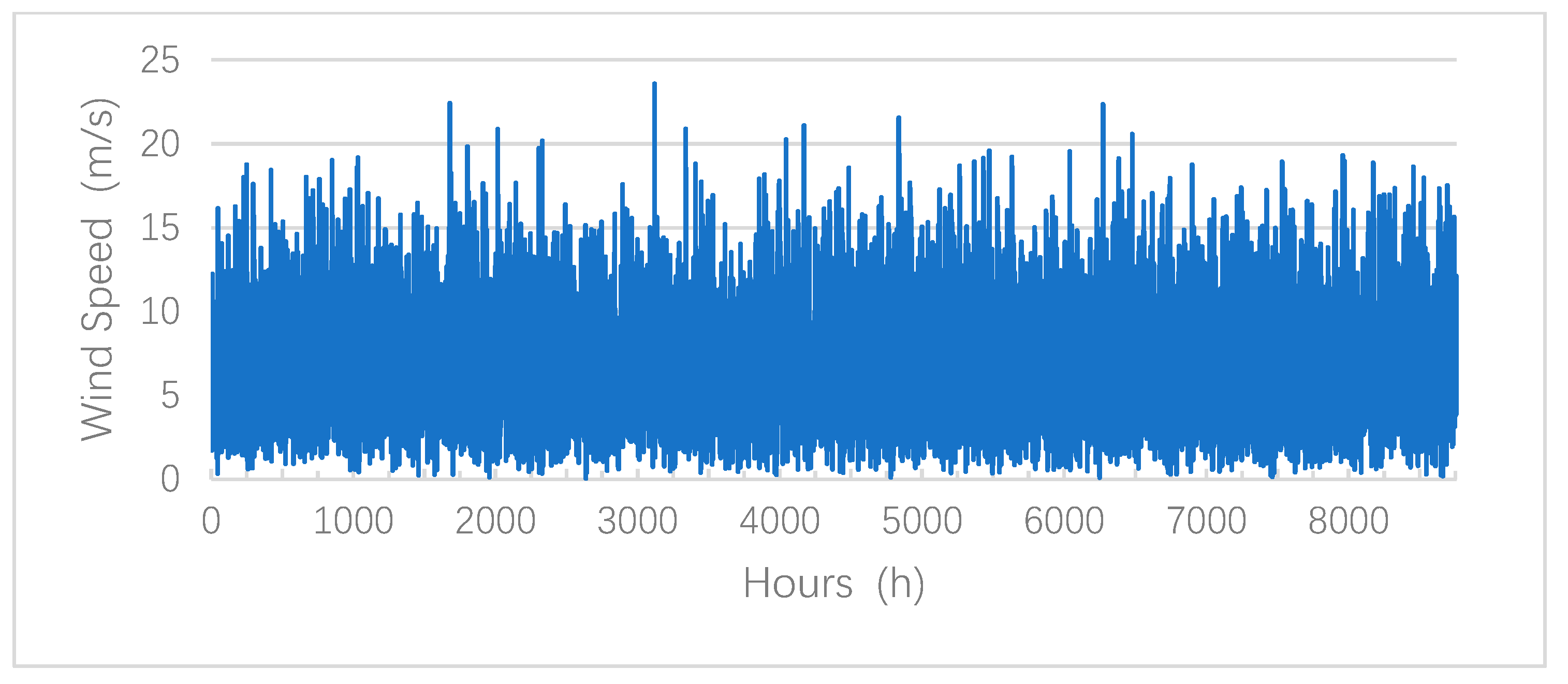
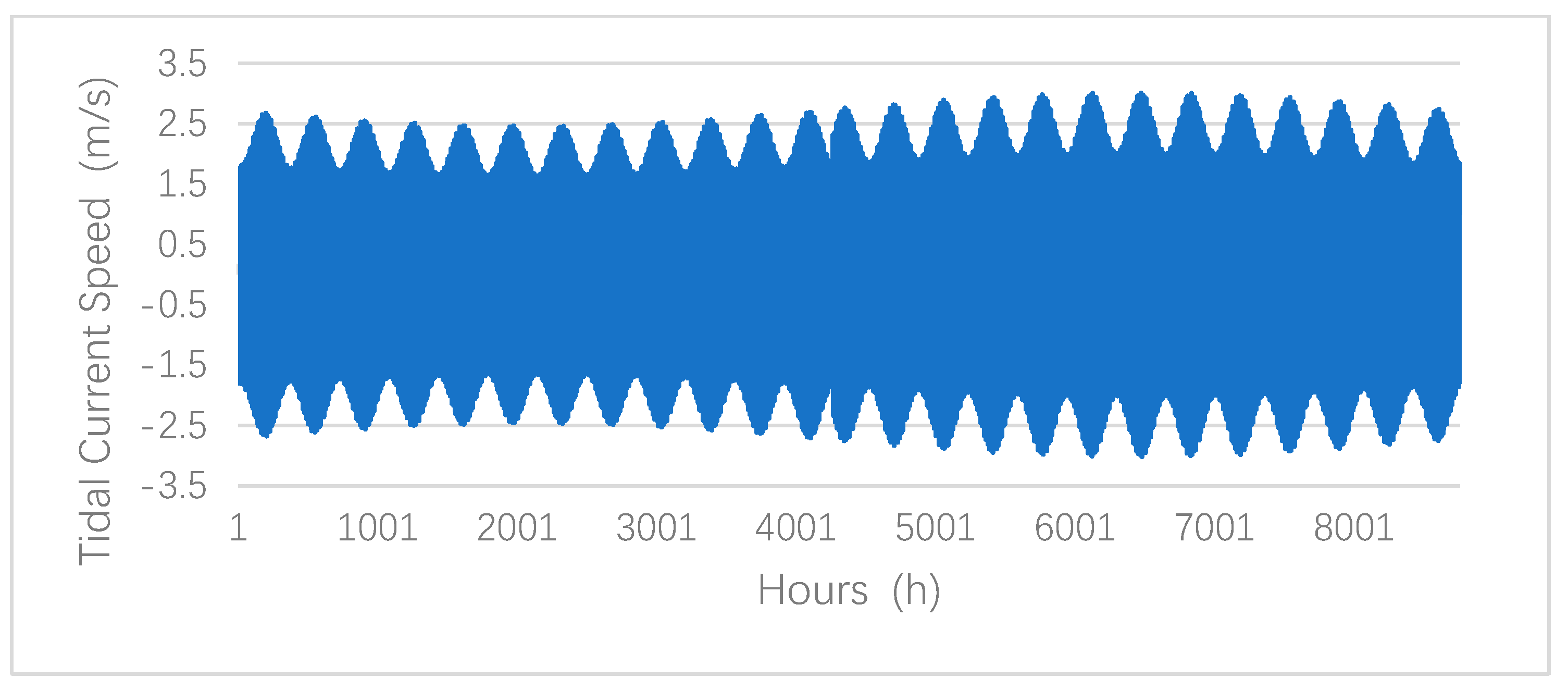
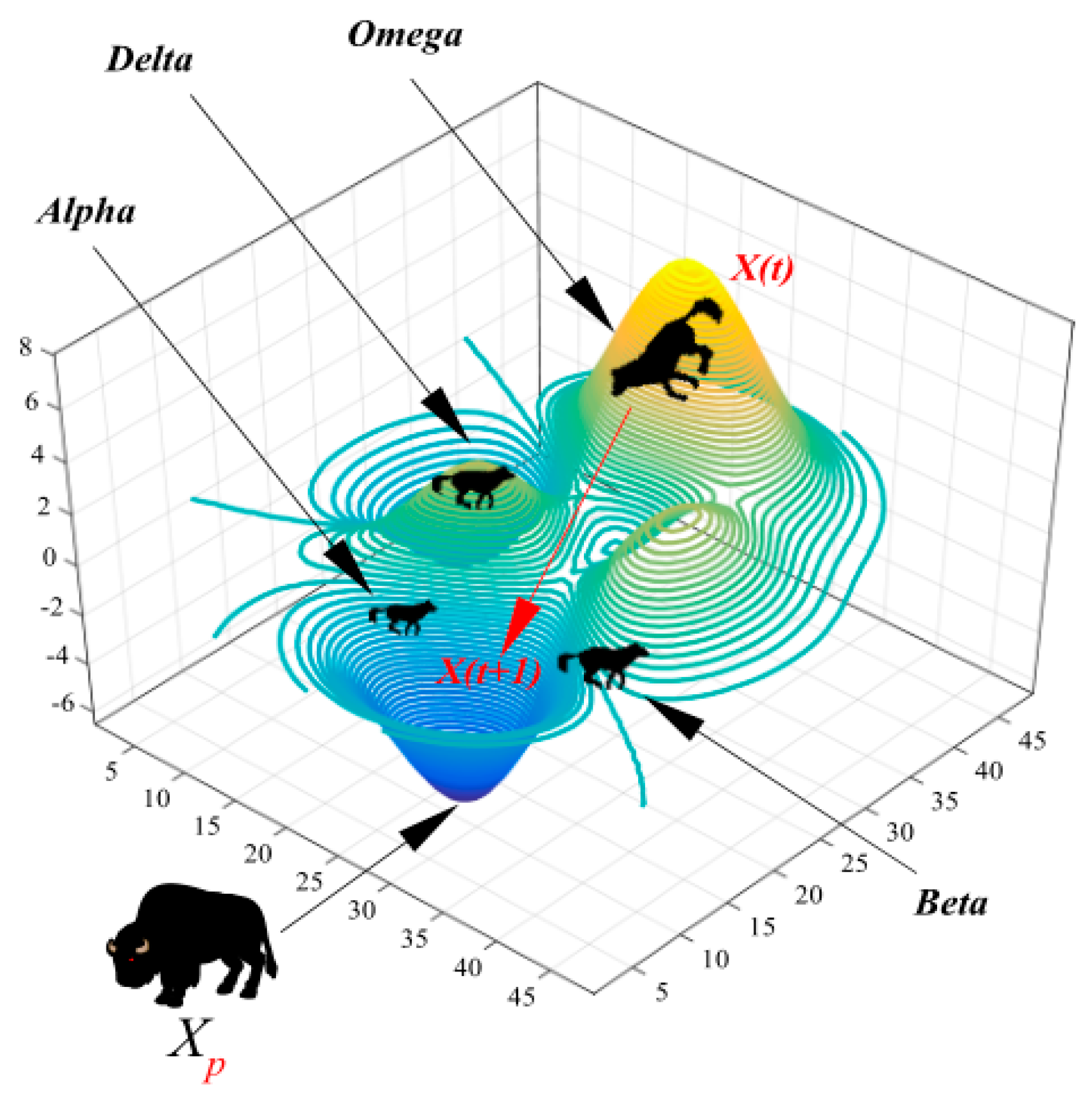
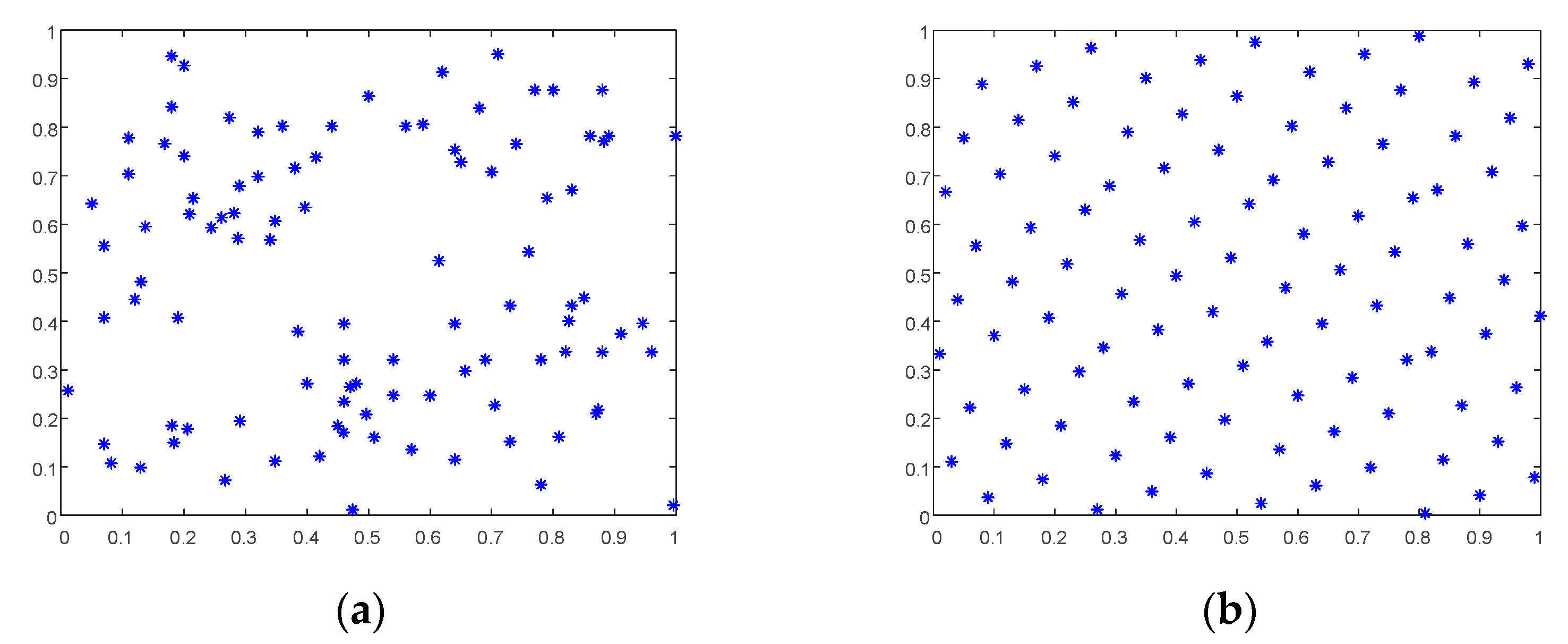




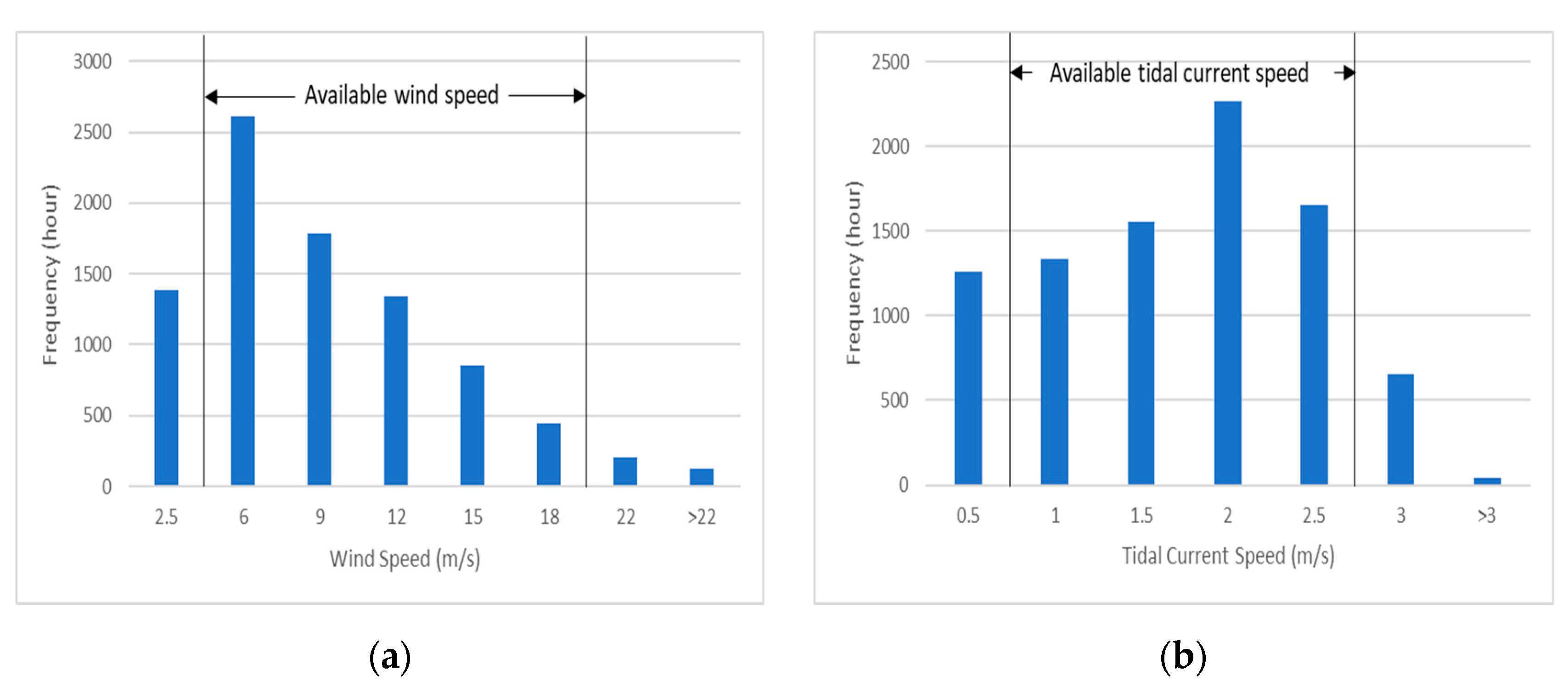


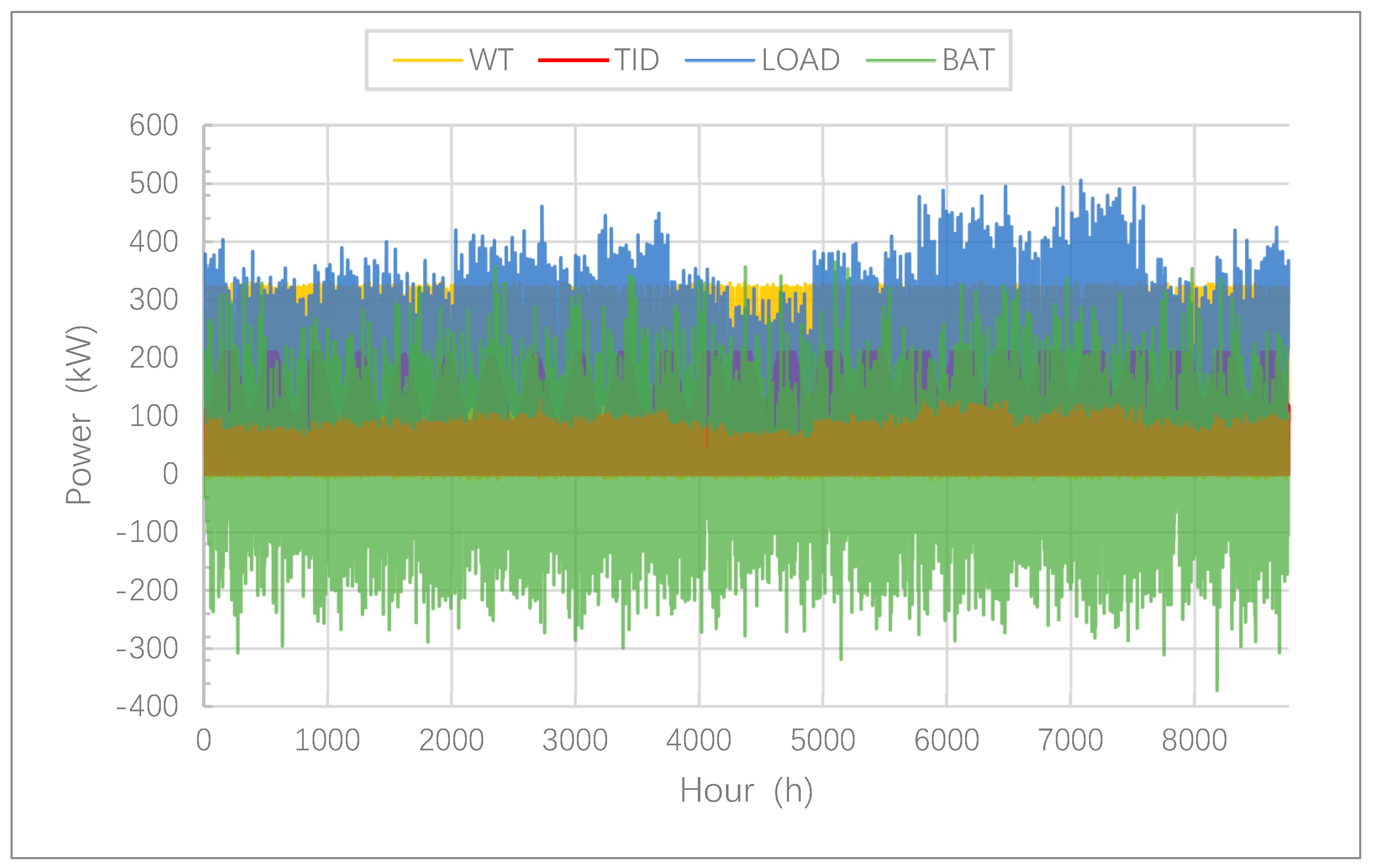
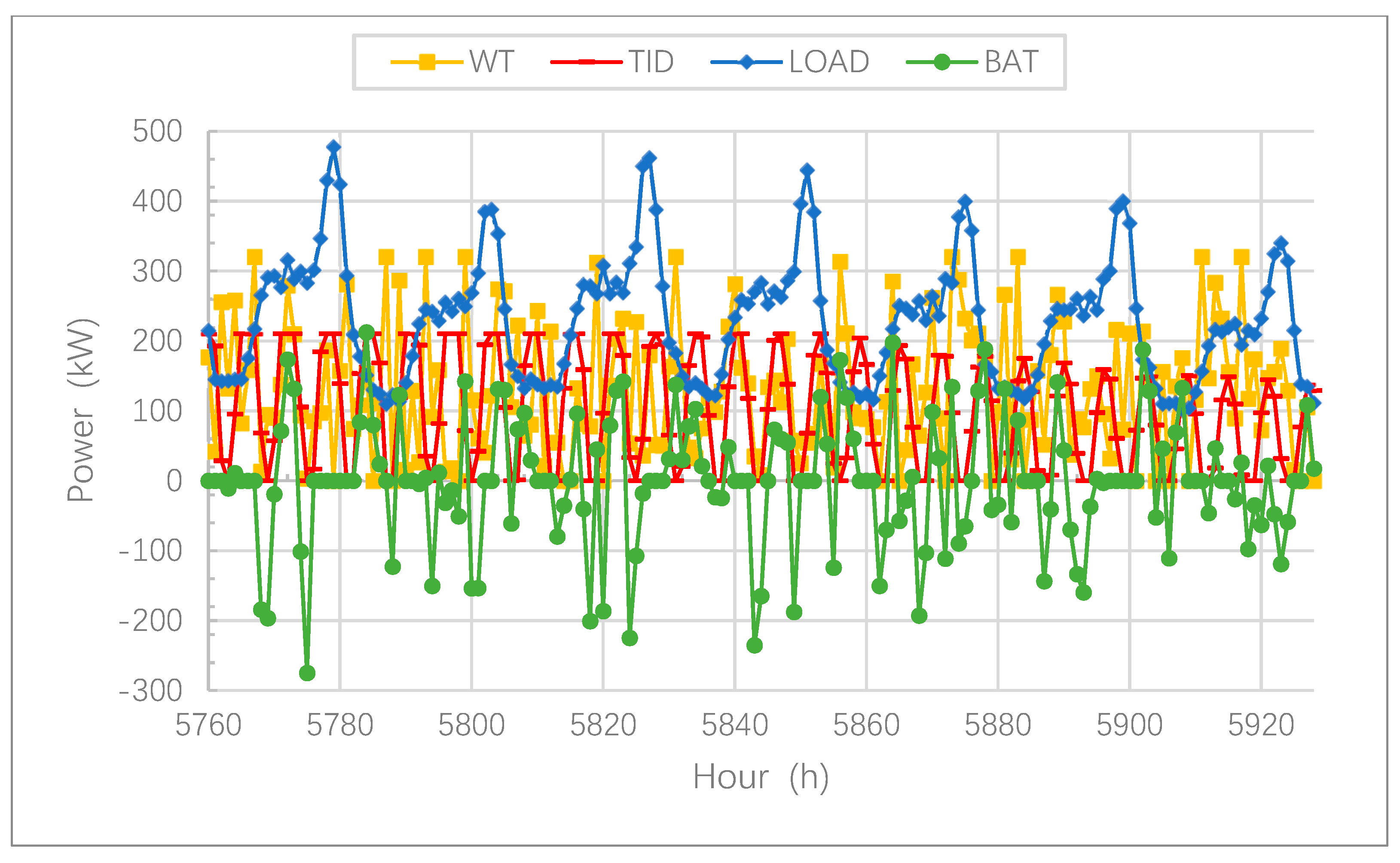


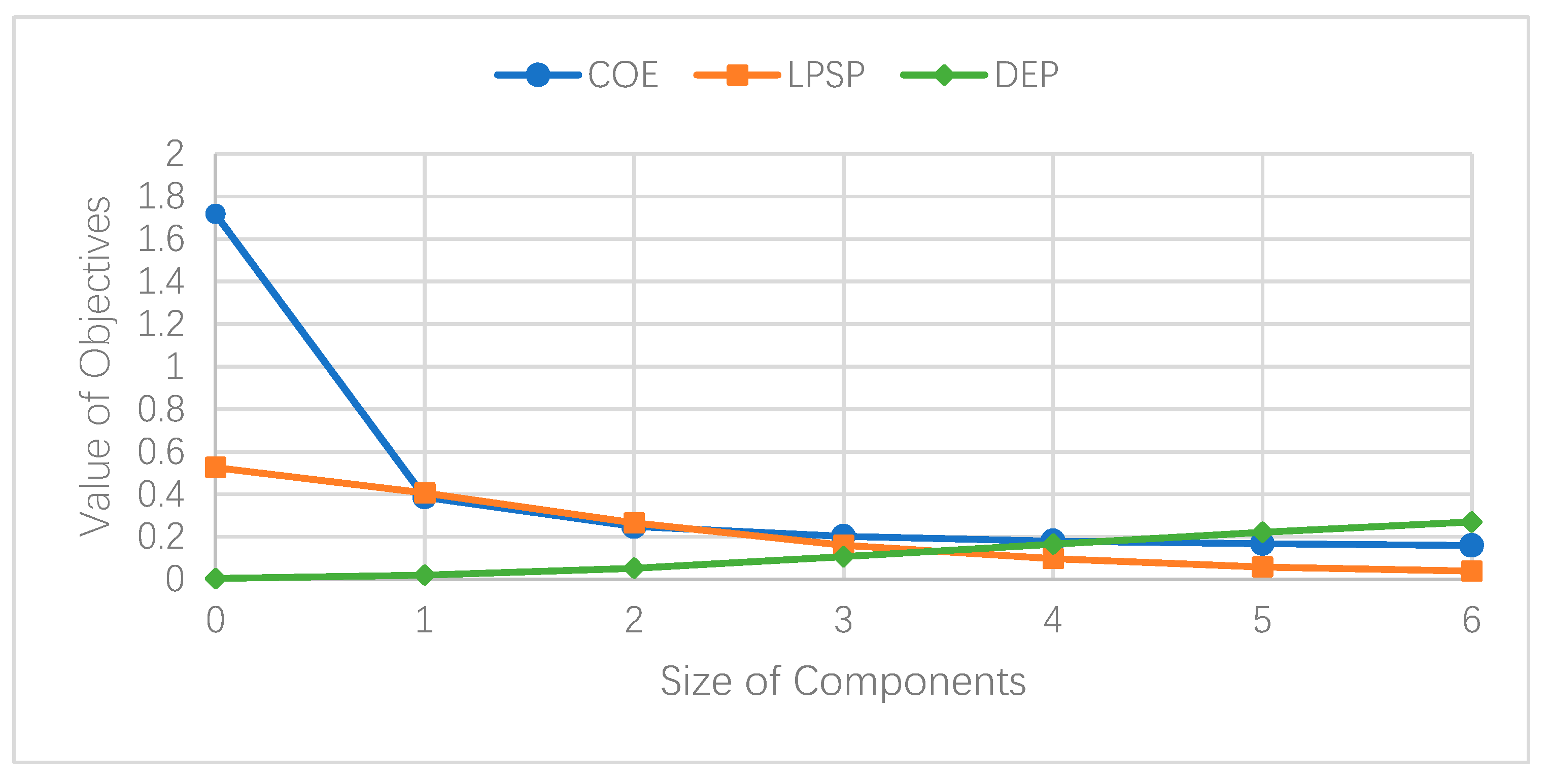


| Names | Average | ||
|---|---|---|---|
| HSMGWO | MOGWO | MOPSO | |
| DTLZ 1 | 0.0836 | 0.1751 | 0.2629 |
| DTLZ 2 | 0.1019 | 0.2586 | 0.4004 |
| Sources | Parameters | Values | Units |
|---|---|---|---|
| WT | Lifespan | 20 | Year |
| Rated capacity | 80 | kW | |
| Efficiency | 95 | % | |
| Initial cost | 3900 | $/kW | |
| Running cost | 3 | % | |
| Cut-in speed | 2.5 | m/s | |
| Cut-out speed | 18 | m/s | |
| Rated speed | 12 | m/s | |
| TCT | Lifespan | 20 | Years |
| Rated capacity | 70 | kW | |
| Efficiency | 95 | % | |
| Initial cost | 4300 | $/kW | |
| Running cost | 3 | % | |
| Cut-in speed | 1 | m/s | |
| Cut-out speed | 5 | m/s | |
| Rated speed | 2.5 | m/s | |
| BSS | Lifespan | 5 | Years |
| Rated capacity | 100 | kWh | |
| Efficiency | 90 | % | |
| Initial cost | 280 | $/kW | |
| Replacement cost | 280 | $/kW | |
| Running cost | 2 | % |
| Parameters | Values | Parameters | Values | Parameters | Values |
|---|---|---|---|---|---|
| Wolves_num | 200 | alpha | 0.1 | nGrid | 10 |
| MaxIt | 1000 | beta | 4 | μ | [0, 1] |
| Archive_size | 100 | gamma | 2 | m | Chaotic |
| Solutions | WT | TCT | BSS | LPSP (%) | COE | DEP (%) |
|---|---|---|---|---|---|---|
| 1 | 5 | 4 | 6 | 5.1 | 0.22 | 36.2 |
| 2 | 3 | 2 | 4 | 19.6 | 0.16 | 13.5 |
| 3 | 2 | 2 | 3 | 26.3 | 0.19 | 4.4 |
| 4 | 4 | 3 | 5 | 9.8 | 0.18 | 16.6 |
Publisher’s Note: MDPI stays neutral with regard to jurisdictional claims in published maps and institutional affiliations. |
© 2021 by the authors. Licensee MDPI, Basel, Switzerland. This article is an open access article distributed under the terms and conditions of the Creative Commons Attribution (CC BY) license (http://creativecommons.org/licenses/by/4.0/).
Share and Cite
Zhu, W.; Guo, J.; Zhao, G. Multi-Objective Sizing Optimization of Hybrid Renewable Energy Microgrid in a Stand-Alone Marine Context. Electronics 2021, 10, 174. https://doi.org/10.3390/electronics10020174
Zhu W, Guo J, Zhao G. Multi-Objective Sizing Optimization of Hybrid Renewable Energy Microgrid in a Stand-Alone Marine Context. Electronics. 2021; 10(2):174. https://doi.org/10.3390/electronics10020174
Chicago/Turabian StyleZhu, Wenqiang, Jiang Guo, and Guo Zhao. 2021. "Multi-Objective Sizing Optimization of Hybrid Renewable Energy Microgrid in a Stand-Alone Marine Context" Electronics 10, no. 2: 174. https://doi.org/10.3390/electronics10020174
APA StyleZhu, W., Guo, J., & Zhao, G. (2021). Multi-Objective Sizing Optimization of Hybrid Renewable Energy Microgrid in a Stand-Alone Marine Context. Electronics, 10(2), 174. https://doi.org/10.3390/electronics10020174





